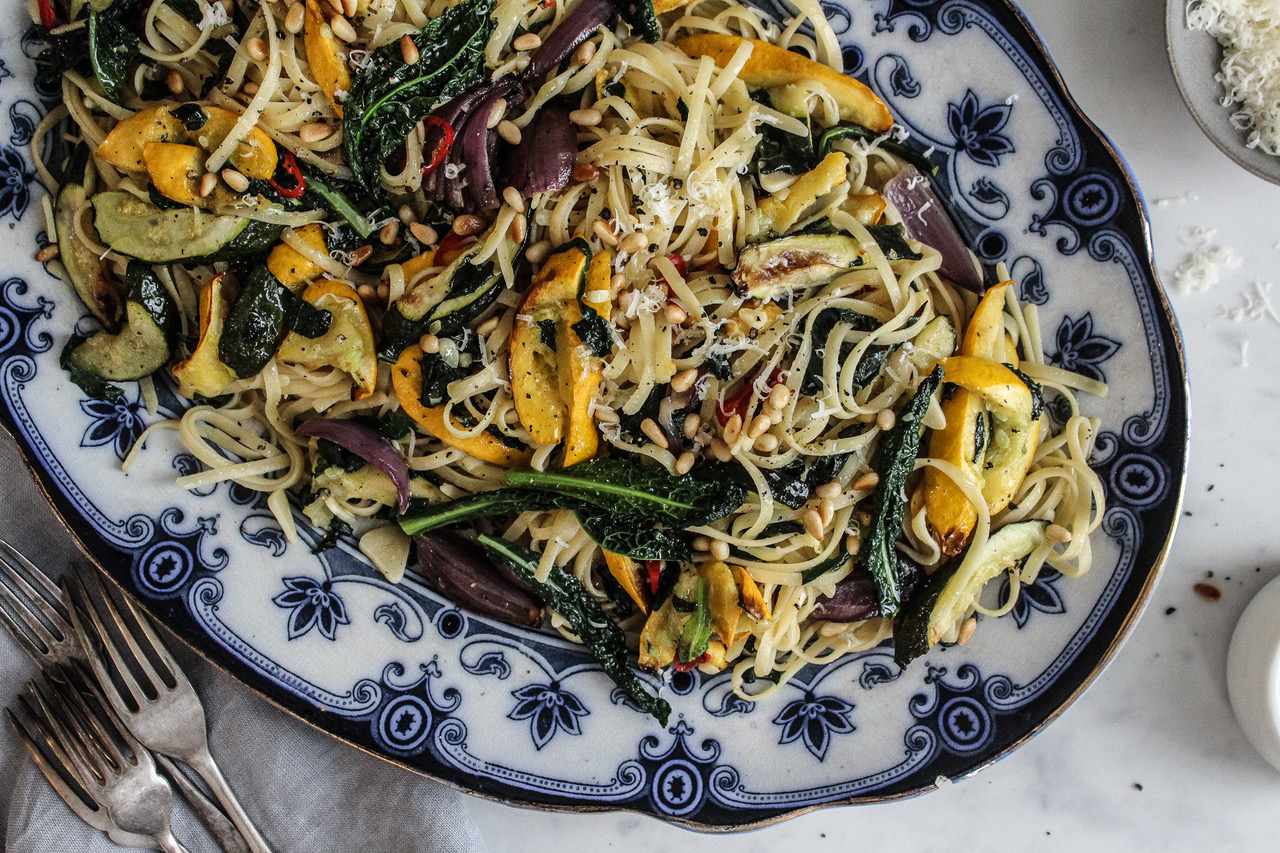Cavolo Nero, Roasted Courgette & Chili Linguine
Sommer Pyne
Looking for some dinner inspiration? Who doesn’t love a big bowl of steaming hot pasta with a tonne of freshly grated parmesan chucked on top. Pasta for us is the ultimate comfort food so we just had to share this delicious Cavolo Nero, Roasted Courgette & Chill Linguine recipe from Erica @naturallynourishedlondon Erica is a London based Nutritional Therapist and on her blog you will find lot’s of hearty recipes, science-based health articles plus beauty & wellness tips. Take a look here Erica’s blog. Over to you Erica….
The cavolo nero, otherwise known as Tuscan kale lends itself well to this dish and provides you with all the nutritional benefits that come with cruciferous veg (see below!). The toasted pine nuts and a creamy nutty texture and the hit of spice from the chili rounds the dish off beautifully. We hope you enjoy, like, comment below and let us know if you try it. x
Prep time: 15 minutes cook time: 25 minutes serves: 4
INGREDIENTS
200g/2 cups cavolo nero ~ finely chopped with stalks removed
1 yellow courgette ~ sliced on the diagonal then halved again
1 green courgette ~ sliced as above
1 red onion ~ cut in to 6
2 red jalapeño chili ~ finely chopped
6 cloves of garlic ~ finely chopped
400g linguine
50g/1/3 cup of pine nuts
30g of parmesan ~ finely grated
Olive oil
Himalayan salt and pepper
METHOD
1. Preheat oven to 200°C/180°Fan/Gas 6
2. Place the courgette and onion into an oven-proof dish or baking tray. Evenly coat the veg with a little olive oil and a sprinkle of salt and pepper. Place into the oven for around 20 minutes making sure to turn them halfway.
3. Whilst the veg are in the oven start with toasting the pine nuts in a pan over medium heat for a few minutes until they start to brown slightly. Remove from the pan and set aside.
4. Heat about a tablespoon of olive oil in a large frying pan over medium heat. Add the red chili and cook for a 2-3 minutes until it softens. Add the garlic and cook for a minute until it starts to turn translucent. You don’t want it to brown!
5. To the same pan, add a little more olive oil if needed and add the cavolo nero. Cook for about 4 minutes, stirring frequently until it starts to wilt down then add a splash of water to the pan and continue cooking for another few minutes. Turn the heat off and leave to one side.
6. Next cook the pasta. Bring a large pan of water to the boil, add a good pinch of salt and then add the linguine. Cook for roughly 8-10 minutes. You want to keep it slightly al dente. Add a small amount of the pasta water to the same pan with the kale, garlic and chili and turn to low heat. Drain the pasta and add straight to the pan. Toss it around, mixing all bits together, add a drizzle of olive oil and salt and pepper to season. To the same pan, add the roasted veg and toss together.
7. Serve into pasta bowls and top with the toasted pine nuts and a generous helping of grated parmesan. Sit back and enjoy!
Tip: To remove the stalks from the cavolo nero, run a sharp knife down the entire length of the stalk on both sides. Don’t remove stalks once it’s chopped or you’ll be there all day!
NUTRITIONAL BROWNIE POINTS
Cavolo nero is a good source of magnesium, which is an essential mineral for energy production within the body and low levels have been linked to fatigue. It is also essential for the regulation of muscular contraction, blood pressure and nerve transmission.
It is also a fantastic source of beta-carotene. Part of the carotenoid family, it’s a potent antioxidant and precurser to vitamin A. Beta-carotene has been widely studied for it’s skin protective properties such as:
~ It has photo-protective properties and has been shown to protect against sunburn development by inhibiting free radials and suppressing our cellular and tissue response to inflammation.
~ It also prevents premature aging of the skin. Studies have shown it to prevent wrinkle formation by decreasing the activity of the enzymes (MMP) responsible for collagen degradation.
~ In the epidermis (outer layer of skin), b-carotene is deposited and works to fight free radical damage caused by UV exposure. It is also protective against the development of skin cancer.
Cavolo nero also belongs to the cruciferous family along with veg like cauliflower, broccoli, sprouts to name a few. Sulforaphane is a compound found in all cruciferous veg and has been extensively studied due to it’s anticancer properties.
Studies have also shown sulforaphane to be protective against neurodegerative diseases. It is able to cross the blood-brain barrier (BBB) – a highly selective semi permeable membrane that separates the brain and the blood. Once it crosses the BBB it accumulates in the central nervous system and exerts neuroprotective effects.
Lutein, like beta-carotene is a carotenoid present in green leafy veg such as cavolo nero. It can decrease the intensity of erythema (red skin) induced by UV-light and also has the ability to filter blue light (computer screens, phones and the sun!), which causes lasting damage to the skin. It may be worth increasing your intake prior to going on holiday to allow for more UV protection!
Cavolo nero sure packs a nutritional punch!
Recipe and words by Erica Rodriguez - Naturally Nourished




